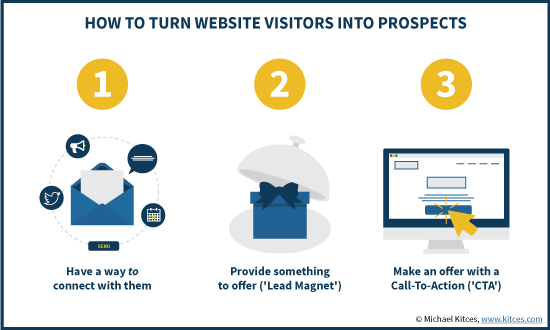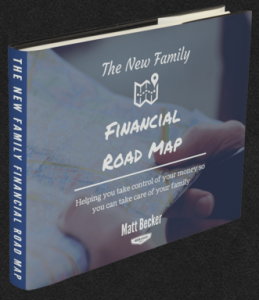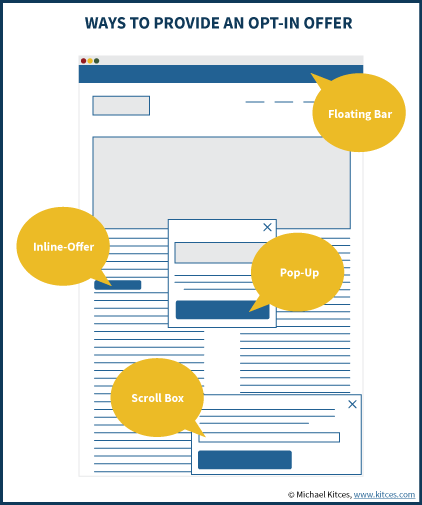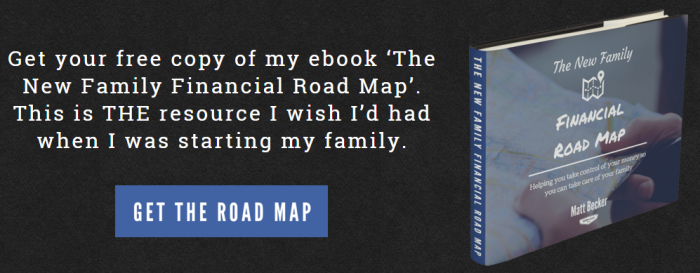Executive Summary
In the early years of the internet, a website was like a digital business card or a marketing brochure – a place for consumers to look up basic information to contact a business, including a financial advisor.
In today’s world, however, consumers use websites in a far more sophisticated manner – gathering information and ‘studying’ a number of businesses for an extended period of time, before ever being ready to contact the advisor with the intent to do business.
The question, then, is how to take casual visitors to an advisor’s website, and engage them in a manner where they will come back when they’re ready. The answer: to use the digital visit as an opportunity to make a “digital connection” by persuading the visitor to opt into joining your mailing list... which gives you the opportunity to stay connected with them, until they're actually ready to do business.
In fact, notwithstanding the massive growth of social media in recent years, marketing studies find that email still drives business 40X more effectively than social media. And a proliferation of new tools from companies like SumoMe, OptInMonster, and LeadPages have made it easier than ever for advisors to use such solutions in their own marketing process.
Ultimately, the reality is that such marketing strategies are really no different than the drip marketing strategies that many financial advisors have engaged in for years, simply delivered – and leveraged – with the power of the internet!
Website Strangers Aren’t Ready To Engage A Financial Advisor… Yet
The internet is a phenomenal tool for gathering information. If you’ve been told about a good business or service provider, their website is a place to go to look up more information. Sometimes the website – or an article on that site – may have even been shared with you directly, when a friend or colleague emailed it to you or posted it to social media. In many cases, we find our way to new information by literally just typing our questions into Google, and letting it serve up the answer.
When it comes to purchasing physical products, sometimes the information on the internet is enough. We know what we’re looking for, we can look up the reviews, buy it on the spot, and have it delivered directly the next day. Soon an Amazon drone might just drop the product off that afternoon!
In the case of services, however, the process is generally much slower. A service is invisible and intangible, for which there usually is far less information available. As a result, we are forced to make a purchasing decision based on our perception of the company’s trustworthiness and reputation – in other words, its brand. And establishing in the prospective client’s mind that yours is a brand they know, they like, and that they can trust, takes a lot time.
In fact, the typical prospect client inquiry that we receive digitally through our website follows a remarkably consistent format, such as:
Michael,
First found your stuff a couple months ago when I was searching for something online. Thought it was pretty good and decided to sign up for your mailing list.I’ve decided that I’m going to retire at the end of this year, and take the lump sum from my pension as I read on your site it’s often better to do that when interest rates are low. But now I’m not certain what’s the best way for me to start taking distributions from this retirement account, and I’m worried about the tax bill that’s coming.
I’ve seen enough of your articles to know you’re a real expert on retirement issues like this. When can we meet to discuss how we can work together?
As the above inquiry demonstrates, the typical online prospect doesn’t just come to your website once and decide to do business with you. Instead, he/she evaluates your website and content, decides if you’re someone worth connecting to, receives your ongoing material that demonstrates your expertise over a period of time, and then when a need or problem arises, you’re top-of-mind as the trusted go-to person for them to contact.
4 Key Elements For Financial Advisor Lead Generation Online
The fundamental challenge of turning financial advisor website visitors into prospective client leads is that you need a way to connect with those visitors, to ensure that they actually do come back again, when their need arises. Because no one is likely to hire you the first time they visit your website, and they may not even be ready to work with you quite yet.
This means that you will need to focus on three key elements of connecting with a visitor to turn them into a bona fide lead:
- Have a way to connect with them
- Provide something to offer
- Make an offer with a Call-To-Action

We explore each of these key steps below.
Have A Way To Connect With Website Visitors – Build A Mailing List
The first step in connecting with website visitors to be able to drip market to them and get them to come back again is actually having a way to connect with them in the first place. In other words, how should they connect with you? Via an email list? Via a social media platform like Twitter, Facebook or LinkedIn?
Notably, while the marketing buzz in recent years has been all about the rise of social media, marketing research still shows that email is actually far more effective as a channel for getting new customers or clients… by a factor of nearly 40:1. In other words, it’s all about email addresses, in part because an estimated 91% of all US consumers still use email daily.
Of course, this doesn’t mean that social media channels should be ignored. But ironically, it implies that even for advisors who do adopt social media, the best strategy is to try to leverage that social media into website visitors and then get them to sign up for your email list (a lesson I had to learn the hard way!). In other words, getting email addresses gets business, and social media may help get email addresses.
Whether it will be via email or social media, though, as a financial advisor you should have a clear plan as to the primary objective of what you want your website visitor to do – is it connect with you on a particular social media platform, or add themselves to your email list, or something else? What’s the key performance indicator you’ll use to judge if this first step of your marketing funnel is working?
Have Something To Offer (A Lead Magnet)
The next step in making a digital connection with your website visitors is to provide them with something of value, that is compelling enough for them to agree to connect with you (and turn over their email address).
For instance, you might offer an e-book with educational content that is relevant for the people you’re trying to reach. Notably, the more targeted your prospective clientele are, the easier it will be to create a compelling lead magnet. After all, “Get Our 6 Tips To Improve Your Investment Portfolio” isn’t likely to persuade anyone, given how much similar information is already available out there for free to anyone who searches.
 By contrast, Matt Becker of Mom and Dad Money – which as the name implies, is a financial planning firm for (new) parents trying to navigate the financial complexities of starting a family – offers an e-book guide relevant for the exact kind of prospective clients he’s trying to reach.
By contrast, Matt Becker of Mom and Dad Money – which as the name implies, is a financial planning firm for (new) parents trying to navigate the financial complexities of starting a family – offers an e-book guide relevant for the exact kind of prospective clients he’s trying to reach.
Similarly, Dave Grant of Finance For Teachers provides financial planning services for teachers, and offers an e-book on financial tips written specifically for teachers. And Larson Financial Group, which specializes in doctors and dentists, wrote “Doctor’s Eyes Only: Exclusive Financial Strategies for Today’s Doctors and Dentists” (which they actually sell as a physical book via Amazon, and provide visitors to their website a chance to download the first chapter for free).
Of course, the reality is that these “lead magnets” will not be compelling to most people. They will only ever be relevant for a small subset of people – those who happen to be doctors, teachers, or new parents. But of course, if those are the niche clients you serve, that’s perfect. And for those prospective visitors who come to the website and see these unique resources, they’re compelling precisely because they’re not just written for everyone, but instead feel as though it was written just for them. The exclusivity is actually part of what makes it compelling.
Offer It To Them With A Call To Action
The last part of making a digital connection with your website visitors is that you have to actually ask them to make the connection. In other words, you have to present them with the offer (to get your e-book or other lead magnet), and direct them to the next step by asking for their email address.
In the world of (digital) marketing, this is called having a “Call To Action” – a direct, outright prompt to the reader of what, exactly, they’re supposed to do next. The concept may sound belittling – shouldn’t people just know what comes next – but the psychology of the call to action is that our brains actually find it satisfying and expect that an offer will have a clear call to action at the end.
For instance, Matt Becker’s Offer and “Call To Action” are clearly stated on his website: here’s the ebook, it’s a great resource I wish I’d had, and a clear button to click to Get The Road Map (which in turn pops up a window the visitor can fill out their email address to complete the process).
Creating a lead magnet resource without providing a clear offer and call to action is the sales equivalent of pitching your financial planning services to a prospective client but never actually asking them to do business with you. Just as with any sales situation, it’s crucial for you to ask for the “close” to help the person you’re trying to reach move along to the next stage. Even if someone wants to do business with you (or at least, connect with you and provide you their email address), they are still expecting you to ask for it, which means it’s crucial to actually do so!
Tools To Implement The Email List Building Process
As digital marketing strategies have grown, the good news is that there’s been a proliferation of in the number of software tools available to help.
Opt-In Subscription Software Tools
The first group of solutions are tools that were built specifically to make it easy for a website owner to embed an offer with a call to action somewhere on their website. This can take on several forms, including a “Floating Bar” that appears across the top of the screen, a “Scroll Box” that rolls up from the bottom of the screen, a “Pop Up” that appears on the screen on top of the text (either immediately or after some time has passed), or an “In-Line” offer that appears embedded amongst the other text.

![]() One of the most popular standalone solutions to implement this is SumoMe, which has a series of modules to provide a “SmartBar” (their version of a floating bar), a Scroll Box, and a Pop-Up (which they call “List Builder”). Each of the tools is available in a basic form for free, and has more sophisticated (and customizable) versions at a cost of $20/month.
One of the most popular standalone solutions to implement this is SumoMe, which has a series of modules to provide a “SmartBar” (their version of a floating bar), a Scroll Box, and a Pop-Up (which they call “List Builder”). Each of the tools is available in a basic form for free, and has more sophisticated (and customizable) versions at a cost of $20/month.
![]() Another alternative is OptInMonster, which similarly has tools to create a floating bar at the top of the screen, a slide-in (scroll box) to come up from the bottom, and create “lightbox” pop-ups. A unique feature of OptInMonster is the ability to create in-line offers that are embedded right into your article text (which is not available from SumoMe). OptInMonster has a basic version for $9/month or a Plus version for $19/month (necessary to get the floating bar) or a Pro version for $29/month (for the scroll box), though significant 40%+ discounts are available for those who purchase annually. If you use all of these features, OptInMonster is cheaper than SumoMe, and is also more flexible and customizable, though that also means it requires more time to configure and setup in the first place (while SumoMe is pretty easy to use out of the box).
Another alternative is OptInMonster, which similarly has tools to create a floating bar at the top of the screen, a slide-in (scroll box) to come up from the bottom, and create “lightbox” pop-ups. A unique feature of OptInMonster is the ability to create in-line offers that are embedded right into your article text (which is not available from SumoMe). OptInMonster has a basic version for $9/month or a Plus version for $19/month (necessary to get the floating bar) or a Pro version for $29/month (for the scroll box), though significant 40%+ discounts are available for those who purchase annually. If you use all of these features, OptInMonster is cheaper than SumoMe, and is also more flexible and customizable, though that also means it requires more time to configure and setup in the first place (while SumoMe is pretty easy to use out of the box).
![]() A related but alternative approach is a service like LeadPages. As the name implies, the focus of LeadPages is to make standalone pages that are designed for the sole purpose of focusing someone to make a decision about your call to action. These “single-purpose” pages are often called “Landing Pages”, with the idea that a consumer might be directed to that page of your website in particular and “land” there first, make a decision about following your call to action, and then proceeding to the rest of the site. You might give prospects a special link that directs them to a custom LeadPage, or you could simply embed a call-to-action on your existing site where the button the visitor clicks will take them to a LeadPage (for instance, that’s what you’re seeing when you go to Dave Grant’s Finance For Teachers website and click on the “Get The Book Hereà” link). If you just want all of your new website visitors to see a special landing page, SumoMe also has a standalone service to do this, called Welcome Mat.
A related but alternative approach is a service like LeadPages. As the name implies, the focus of LeadPages is to make standalone pages that are designed for the sole purpose of focusing someone to make a decision about your call to action. These “single-purpose” pages are often called “Landing Pages”, with the idea that a consumer might be directed to that page of your website in particular and “land” there first, make a decision about following your call to action, and then proceeding to the rest of the site. You might give prospects a special link that directs them to a custom LeadPage, or you could simply embed a call-to-action on your existing site where the button the visitor clicks will take them to a LeadPage (for instance, that’s what you’re seeing when you go to Dave Grant’s Finance For Teachers website and click on the “Get The Book Hereà” link). If you just want all of your new website visitors to see a special landing page, SumoMe also has a standalone service to do this, called Welcome Mat.
Email Fulfillment For Financial Advisors
Notably, regardless of what you use to solicit a website visitor to sign up for your mailing list and take the next step towards becoming a “lead”, you will still need a solution to actually have a mailing list, and a plan to send those people your content (both the lead magnet you promised them, and then drip marketing content on an ongoing basis)!
Popular solutions in this area include MailChimp (easy to use, and free for your first 2,000 subscribers and 12,000 emails per month), AWeber (also fairly easy to use, free up to 500 subscribers with no limit on emails), or Hubspot (a more robust and comprehensive inbound marketing platform, but at a more expensive price point starting at $200/month, plus a $600 onboarding fee). Of course, you’ll also need to be prepared to actually have content to include in your email drip marketing, though the starting point can simply be to take any newsletters you’re already producing for clients, and simply converting them to digital format.
Notably, a few financial advisor-focused solutions are starting to come forward as well to help with the process of email fulfillment for mailing lists (including helping to provide the content to include in an email newsletter), such as Vestorly, Financial Media Exchange (FMeX), or Advicent’s Advisor Briefcase (though additional work may be required to integrate these mailing lists into call-to-action tools like SumoMe, OptInMonster, and LeadPages, as well as pulling your new subscribers into your advisor CRM using available APIs and a service like Zapier).
Focus On List Building, Not Inquiries
Ultimately, the bottom line is that most people who visit your website are likely just in the information-gathering phase, or may be an even more “casual” visitor who is not yet ready to contact you for a one-to-one meeting. And if the only choices you provide them are to contact you for a meeting, or leave, virtually all of them will choose the latter.
The process of building a mailing list is the crucial intermediate step, to engage a website visitor in a way that gives you an opportunity to establish trust and later win their business. Your email list becomes a form of drip marketing - similar to how many advisors have used newsletters to drip market for years - but done in an electronic context. And just as your physical mailing list could be further leveraged into doing a local seminar to turn prospect leads into clients, so too can your email list be used to market an online webinar that does the same thing in the digital world.
In fact, for most advisors, arguably the primary goal of the advisor’s website should be finding a way to make some digital connection that will bring a prospect back later (rather than trying to “close” them on the first visit). It’s no coincidence that you’ll regularly see lead magnets with Calls to Action on some of the best financial advisor websites out there!
Of course, as with any portion of a sales process, there is still a balance to be struck. Everyone can recall websites where the pop-ups and calls to action were SO obnoxious and pushy, that they decided not to keep reading the website at all and just left instead, driven away by the aggressive sales effort. But the good news is that once you’re focusing on a specific outcome – getting visitors to sign up for your mailing list – you can track the results in Google Analytics and begin to test and measure how many of your website visitors are actually doing so, and look for ways to accelerate the growth of your digital marketing!
So what do you think? Are you getting new prospective clients from your website? Have you ever tried building an email list of prospects to drip market to? What solutions have you found that work for your business?





